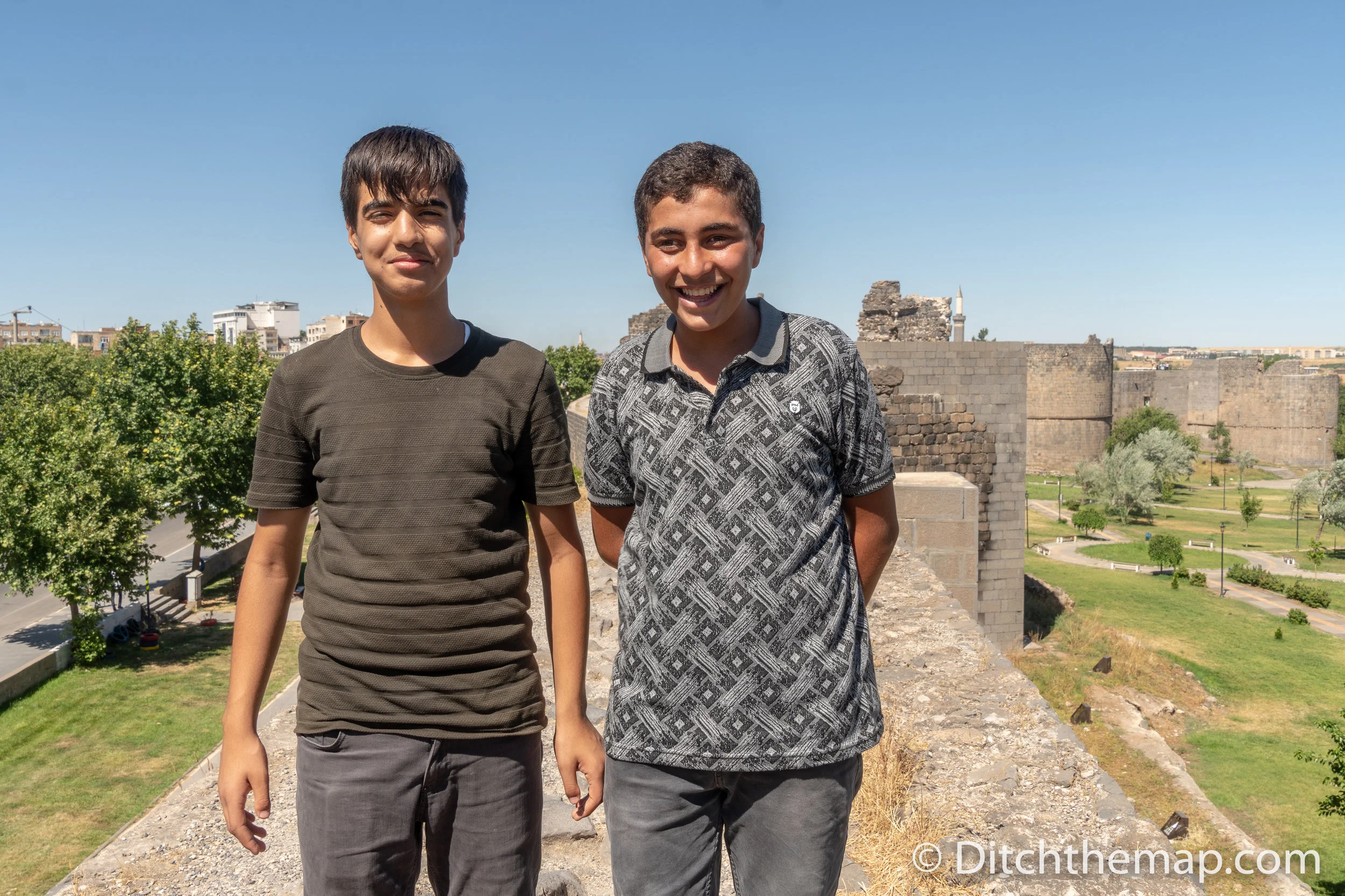Visiting Diyarbakir – The Capital City of Northern Kurdistan - A Travel Blog
/After much research we came up short on finding any travel blog information on the Turkish region of Diyarbakir. Especially for Americans traveling to Diyarbakir there was a nothing available. Only safety warnings to visiting Northern Kurdistan. For this reason I hope this travel blog on Diyarbakir written by two American tourists comes in handy. Note: traveling to Diyarbakir, Turkey is safe, enjoyable, and a must do if visiting Turkey.
En Route to Diyarbakir
The bus from Mardin was relatively uneventful—2 hours and a security checkpoint later we were nearing the city of Diyarbakir, or Amed as is known to the Kurds. The armed policemen went around taking everyone’s IDs while the other police officers waited outside near their armored cars. When the policeman got to us he simply gave us a once-over and kept on collecting IDs. Apparently we did not fit the ‘target demographic’ and our IDs were not required. After scanning each ID our van was free to continue onwards into the city.
The first thing I noticed were the multiple layers of security fences lining the main road into the city. Tall fences with barbed wire on top gave a very clear message—the only way into or out of the city was along the main roads. Lookout towers peppered the landscape as we entered the city proper while concrete barricades and a multitude of armored vehicles greeted us.
Picture of local Kurds atop Southern Part of Wall
About Police Officers
While most police officers were men I did see a handful of female officers—none of them wearing headscarves. Police officers, like many other professions, have obligatory term assignments in less desirable areas. This is due to the socialistic nature of Turkey’s government. I actually find this practice quite positive. Imagine how quickly our racially and ethnically divided neighborhoods would benefit from an influx of outside support. On the flip side envision an inner-city nurse working at a fancy suburban hospital. Talk about broadening one’s horizons.
We also learned that police officers are never allowed to work in their home towns. Because of this Diyarbakir, a city of Kurds, has no Kurdish police officers. Obviously this increases the tension between the Turks and Kurds. Furthermore an extensive background check its conducted to become a police officers and oftentimes the Turkish government finds reasons—sometimes unsubstantiated—to prevent Kurds from being police officers at all.
Man and woman share an embrace in Old City, Diyarbakir
Meeting Our Couchsurfing Host
We were dropped off at a small bus station and we struggled to find a bus into the city. I had been using my google translator app on my phone with little success. I changed the language form Turkish to Kurmanji (which is the Kurdish dialect here in Turkish Kurdistan). This proved to be much more successful. We met our host at a modern café that he owned. We were greeted by another couchsurfer who had arrived just one hour prior. The couch surfer was a 30 year old man from Poland named Robert. He had previously biked through Georgia and Iranian and Iraqi Kurdistan before coming to Northern Kurdistan in Diyarbakir.
Our host was a delightful man named Suat. He told us a lovely story about his first experience hosting where he had hosted a Swedish woman named Mona. This was 12 years ago and was not through couch surfing. Although only planning on hosting Mona. for a couple days Mona ended up living with Suat and his wife for 6 months while she researched Kurdish culture for her thesis. They formed an incredibly close friendship and Suat ended up naming his Café and later his first child after Mona. Mona flew back to Diyarbakir for 2 days for her Birth. Later Suat and his family went to Sweden for Mona’s wedding.
Suat is also a full time teacher in a village. He described his frustration with the village children in how they were troublemakers and didn’t pay attention. Their parents are uneducated and mostly laborers so their children do not see the benefit of education.
Suat told us that he and his wife were different types of Muslim (Sunni vs Shia) and that both of their parents forbade them from getting married. They were married anyways
We discussed Kurdish history and the current state of affairs. This involved detailed comparison of Eastern Kurdistan (Iran), Southern Kurdistan (Iraq), and Western Kurdistan (Syria). Suat explained the PKK to us and I found the information quite interesting. Compared to our host in Van, Suat’s feelings about the matter were different. I wonder if it’s because Suat still lives in the heart of Northern Kurdistan?
A Brief History of Diyarbakir
Diyarbakir, known in ancient times as Amida, has been the cradle of 26 different civilizations over the last 5000 years. Its proximity to a basalt plateau gives the city a rather dark appearance thanks to the dark grey stones found throughout the city. Located in Mesopotamia, the land between the Euphrates Valleys and the Tigris river Diyarbakir’s past involves the Mitanni, the Urartu, Assyria, Persian, Greek, Seleucids, Romans, Arabs, Safavid dynasty, and ultimately conquered by the Ottomans in 1515. They have never known long-lasting peace because in subsequent centuries they were invaded by the armies of Anatolia, Persia, and Syria all of which overcame the city’s walls.
Since the 1980s the city has been the center of the Kurdish resistance movement. Throughout the 1990s many refugees from the conflict between the PKK and the Turkish government move to the city. Just a few short years ago in 2016 there was an altercation between the PKK and the Turkish government leaving a large section of Old City demolished. We witnessed some new construction in the area but could only see inside by climbing onto the city walls and looking down into the city.
Destruction in Diyarbakir from a previous conflict
Safety
Please read our posting on the Safety of Travel in Turkey. Diyarbakir is highest on the list of places to avoid in Turkey. I couldn’t disagree with this more. The city is safe and the people are friendlier than what I thought was humanly possible. There are only two dangers I can see someone encountering in this city—falling off the old city wall and getting sick from the Cig Kofte—I’ll discuss these later
When I mentioned to people that my country strongly advises against travel to Diyarbakir they seemed greatly confused. They said it was just politics and that now it’s very safe. While strolling in Old City we met an Iranian Kurdish family. We talked on the street for 15 minutes. When I explained to her the United States’ stance on travel to this area she gave me an explanation without hesitation. She said it was likely because of Turkey’s government—they were trying to paint the Kurds as terrorists. I found her explanation easy to believe after learning more about the Kurds and Diyarbakir’s history. The family was impressed that Robert, our Polish travel companion, knew more about Iranian Kurdistan than they did. After these last few days Sylvie and I wish to visit Iran in the future.
Sylvie dresses respectfully inside Mosque
Asking new friends for directions
Interesting Facts of Diyarbakir
Pigeons - Pigeons are so highly sought after that Sylvie and I could not quite wrap our heads around it. The reason is actually due to some esoteric history. Pigeons were brought into the city and bred because their feces is helpful for growing watermelon. Watermelon is incredibly popular here. Now that cotton has replaced much of the watermelon crop the love for pigeons is just a carryover from the past. Many older people still love pigeons—so much, in fact, that there are a handful of pigeon clubs around town where the notorious bird is auctioned off for as much as hundreds of dollars. We even heard stories of men selling their homes to buy pigeons. Here you can see a video of a pigeon race here.
Sunflower Seeds – Cheap and plentiful they can be found in buckets for sale around town. Men will down an entire bag while sipping tea and talking to other men. The seeds are eaten with such haste that it is dizzying just watching. While the mouth is busy removing the seeds from the shell the men’s hands are readying for another seed. This endless seed-eating frenzy is associated with the poorer Kurds and a “rich person would never be caught eating a sunflower seed”. Our host went as far as saying he would not even permit someone to eat “those things” in his café.
Dogs – Despite the numerous stray cats in the city we didn’t see too many (if any) dogs. Our host explained to us that there is a story found in Islam where a warrior was about to slay a dog but at the last moment decided not to. While certain muslins interpret this story as the warrior demonstrating mercy many Kurds believe it teaches that the warrior didn’t want to touch the dog because it was unclean/dirty. For this reason you will find many Kurd avoiding dogs completely.
Kurdish Wedding
Our couchsurfing host invited us to his collogues wedding our first night in town. The wedding was half an hour out of the city and we arrived around 9pm. There must have been between 600 and 700 guests at the party. I wore jeans a black polo, and flip flops. Sylvie and Robert were even more casual. No one seemed to care. As is typical in wedding here people eat dinner beforehand and only snacks and drinks are served at the actual wedding. Tables were overflowing with nuts, fruit, and cookies. Men came around offering us glasses of orange Fanta and cola. No alcohol at Muslim weddings made for a wholesome experience. Suat had mentioned that they “went all out” since fruit was expensive.
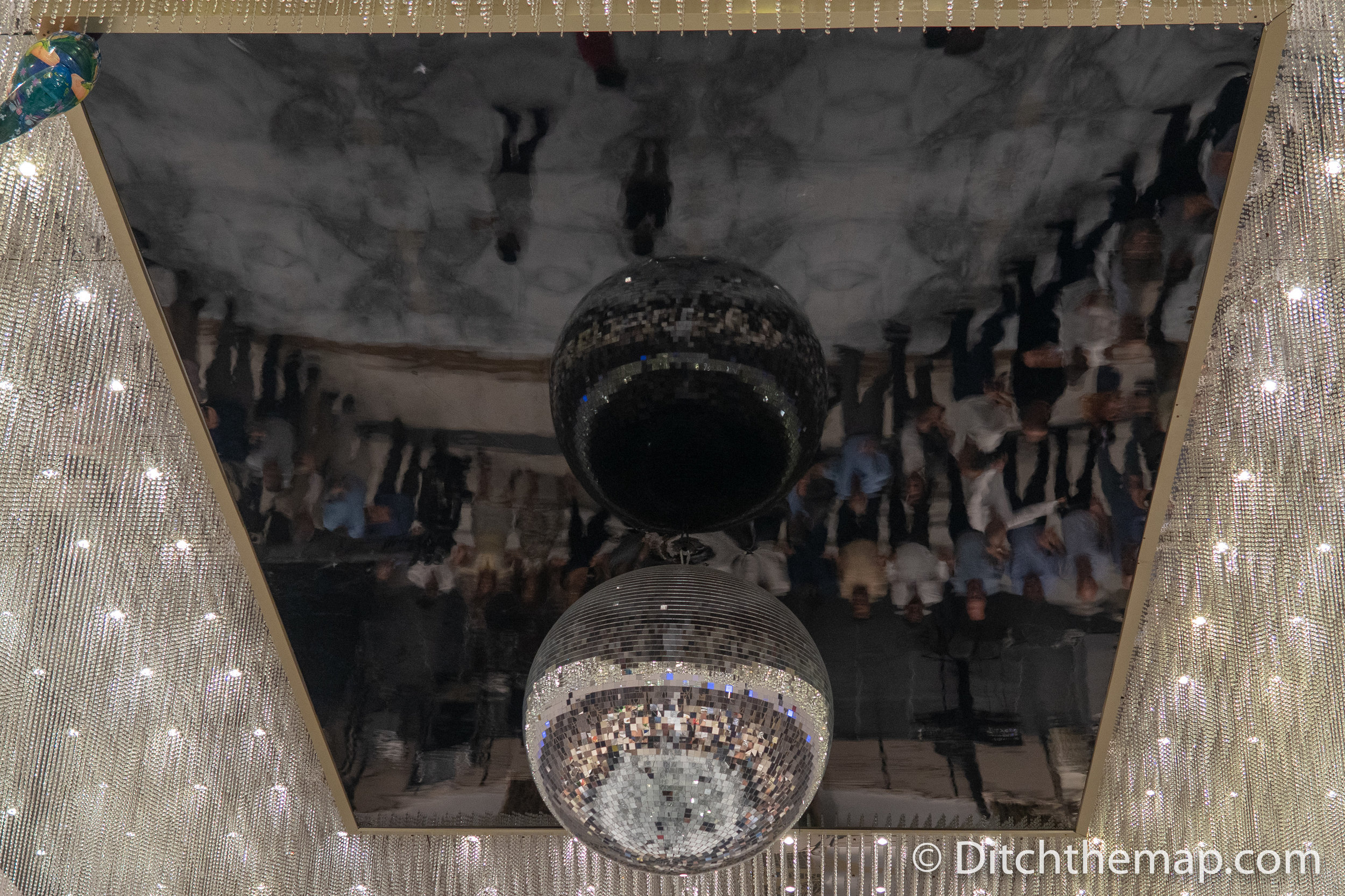
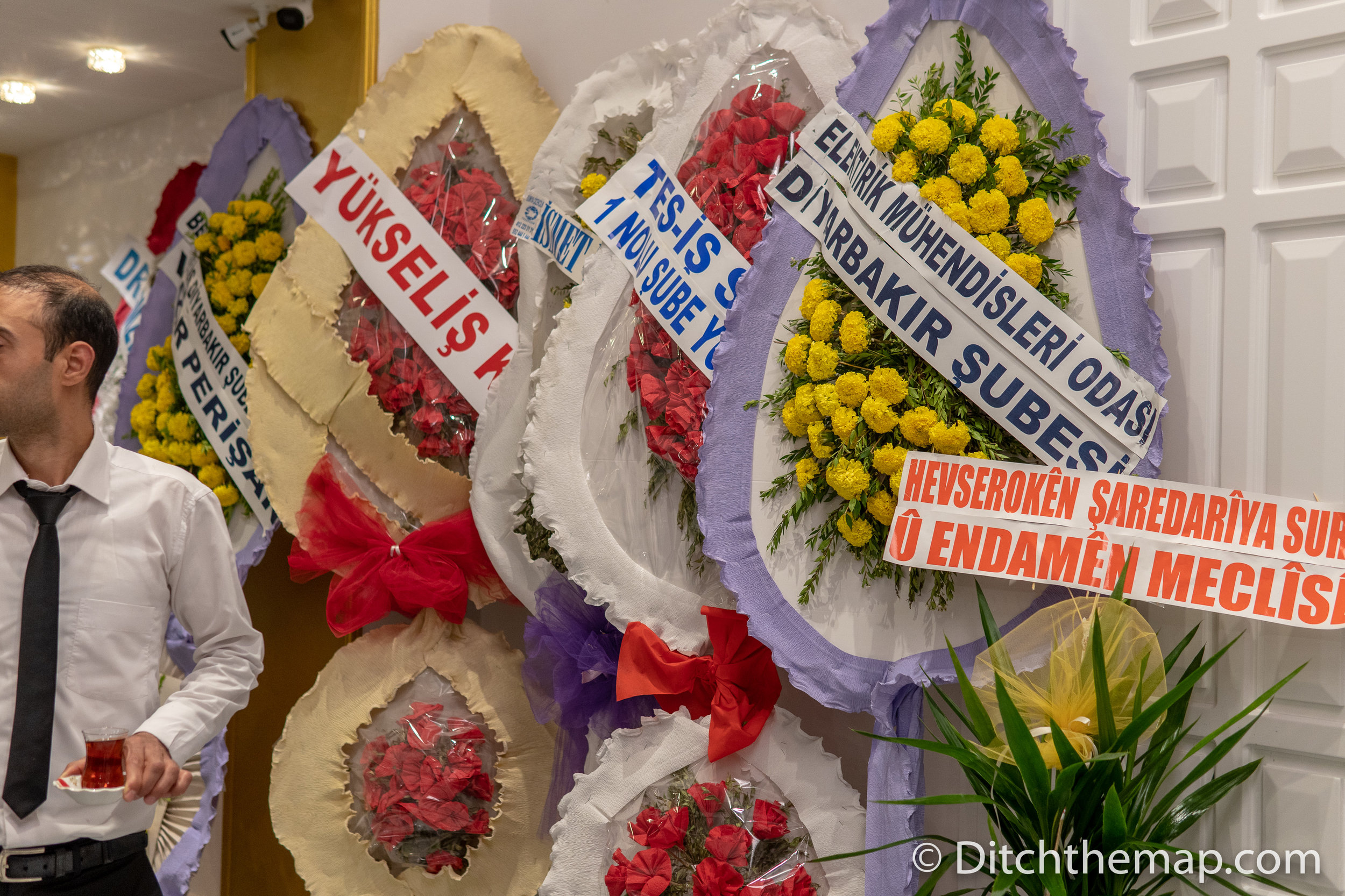
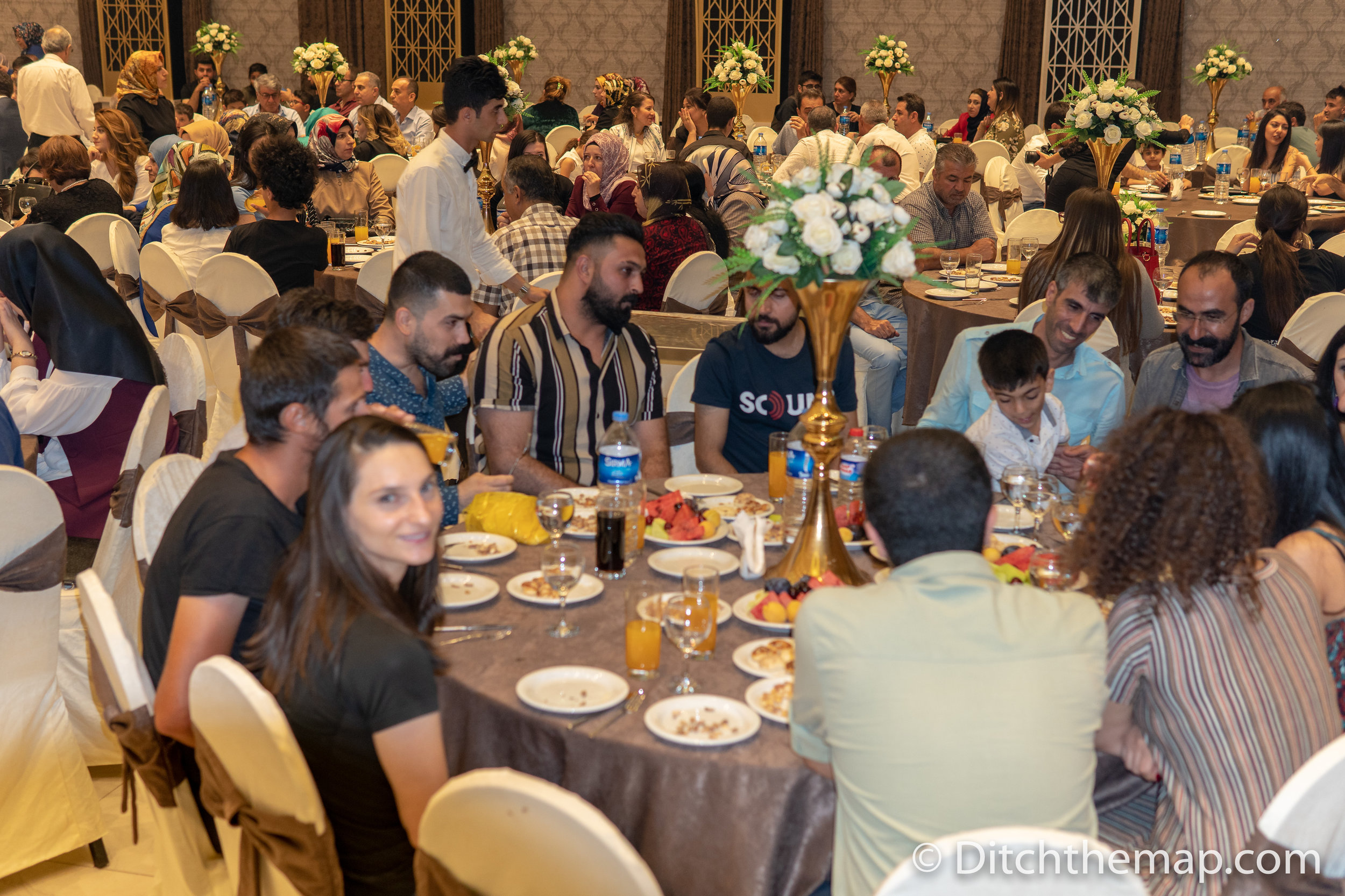
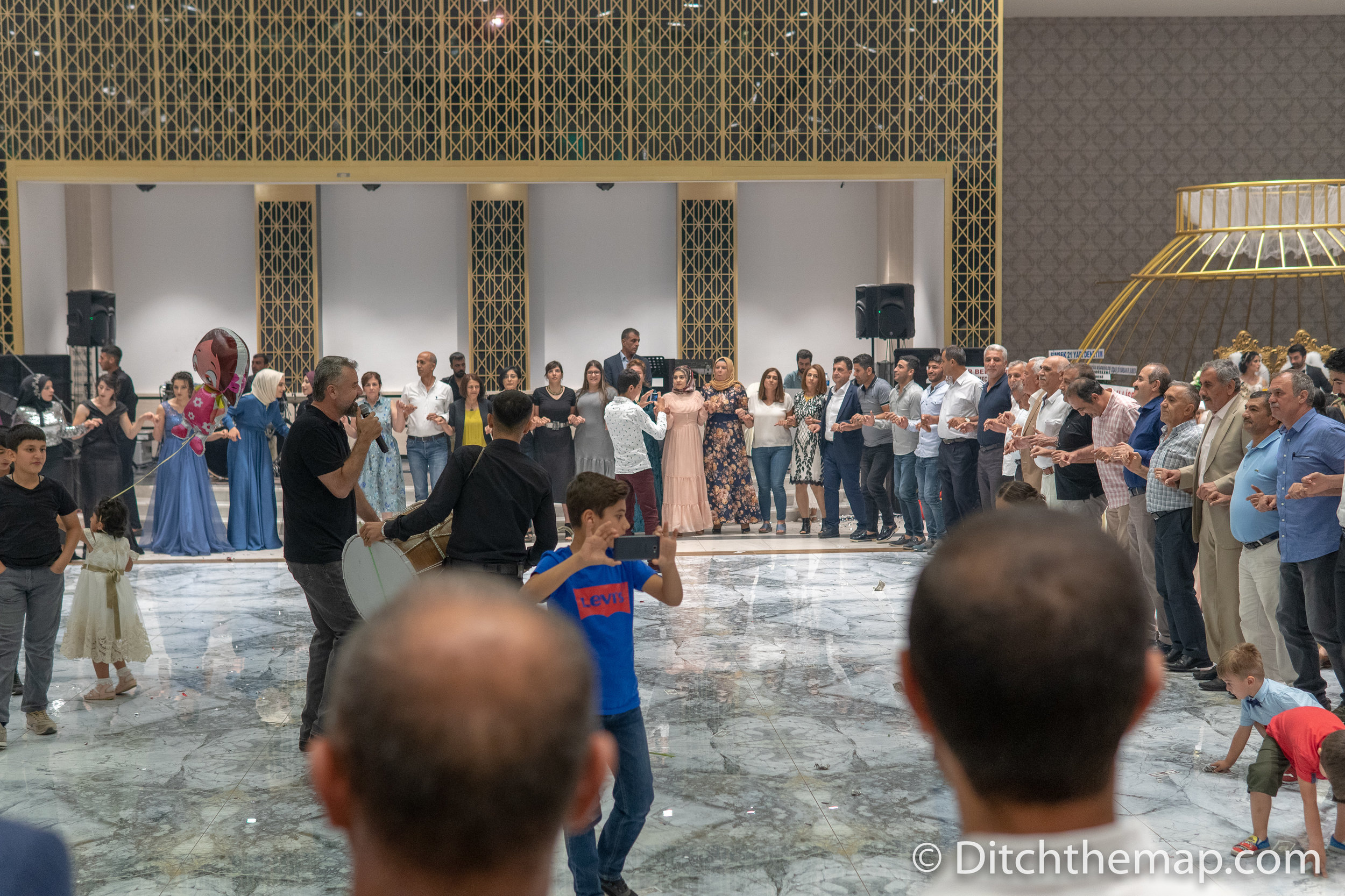

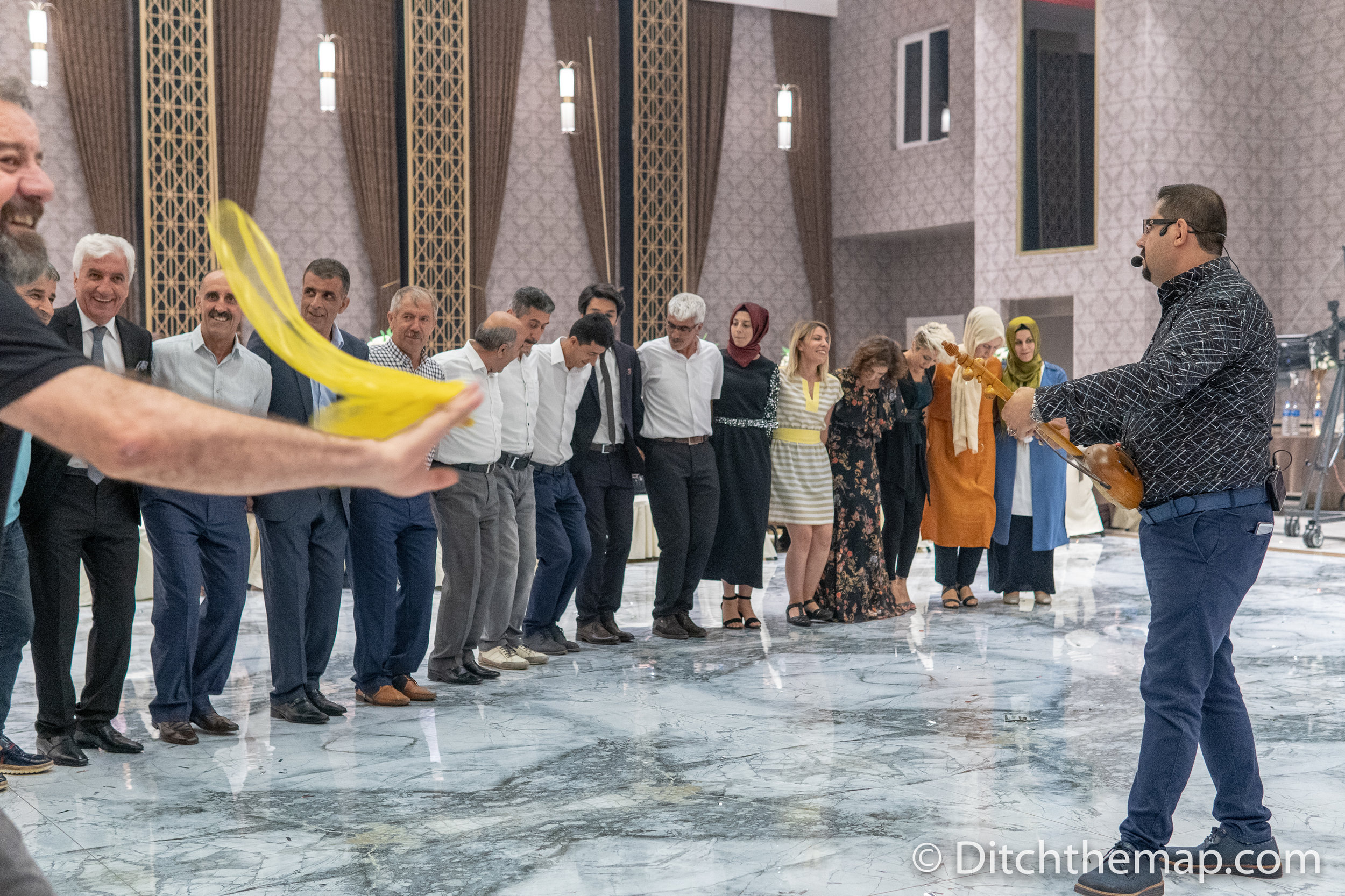

Guests danced off and on throughout the night to traditional Kurdish music. People joined hands and danced in one collective circle. I found an occasional man and women holding hands but this was by far the exception. For the most part women danced with women and men danced with men. There seemed to be 2 or 3 discrete dances but most of them involved bouncing ones shoulders up and down.
Every once in a while a fluttering of American one dollar bills would rain from the sky. Traditionally this was real money but since 5 liras (the lowest denomination of paper money) was too expensive fake money was substituted. You donate a small amount of money and receive a stack of fake dollar bills. You can then throw this fake money into the sky in the center of the dance floor to demonstrate your wealth and generosity.
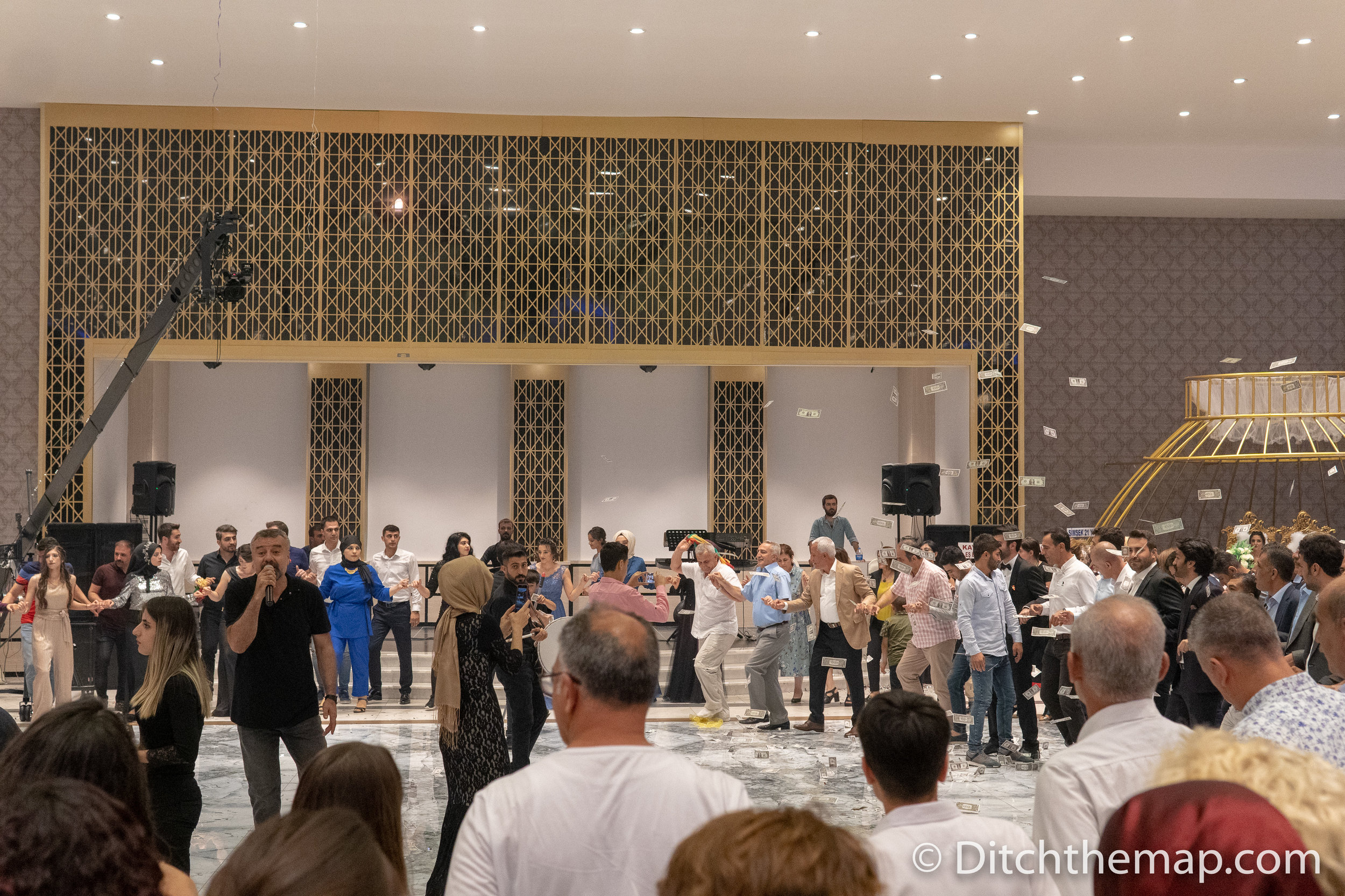
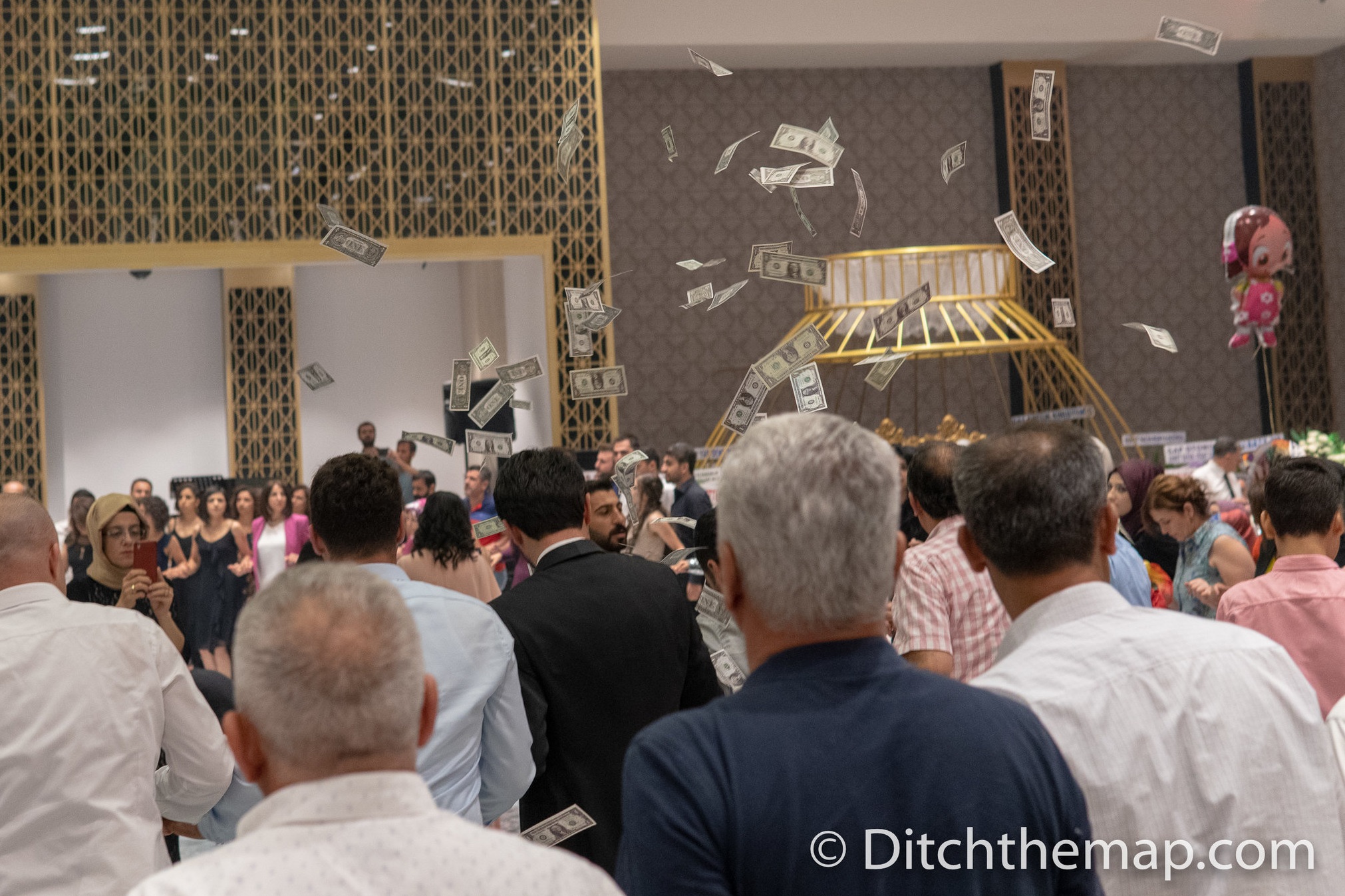
It was customary for each guest to visit the Groom and Bridge and present their gift. Gold coins are the status quo but paper money is also permitted—money is typically reserved for those who cannot afford gold coins. The gold coins, which come as pendants, are standardized and come in a variety of sizes. My guess is that the coins come in multiples of grams. Some coins were as small as a dime while others were larger than a quarter. The guest present the gift and sews the coin onto the newly married couple’s clothing. This is also done for the money. By the end of the night the bride and groom were covered in gold coins, Turkish lira, and even a few $50 US bills. The bride and groom sell the gold coins the next morning and pocket the money. A funny tradition to say the very least.
The cake was cut towards the end of the night. I asked Suat the significance of using a sword to cut the cake, and he just shrugged his head and said “big cake”?
Cutting the cake with sword at Traditional Kurdish Wedding
Observations of Diyarbakir
The vast majority of women did not wear head scarves. Kurdish women traditionally do not wear them until they are married unlike Turkish (and Arabic) women. Dissimilar to Van there were many women in the streets. Our host even said that there a few places around town where you can find single women drinking beers at night. Urfa, the city we are visiting next, has a large Arabic population and is one of the country’s most religious cities—you will not find women alone in the city, without head scarves, or anywhere to drink/buy beer. (check out our next travel blog about Urfa)
Boy shaving a man at barber in Diyarbakir
Man selling juice on the streets of Diyarbakir
Whereas Mardin may have been the most beautiful and enchanting city I’ve seen Diyarbakir has been the most genuine city we’ve visited so far. Although Istanbul was busy and filled with tourists the authenticity of Diyarbakir was palpable. Old City had more shops aimed at tourists than the New City but nothing felt forced. Prices were not inflated and locals shopped alongside tourists. Most tourists seemed to be coming from nearby Kurdish regions. We read most tourists don’t venture out of Old City but we had split our time evenly. Old City had Mosques and history whereas New City had a café culture we have not seen elsewhere in Turkey.
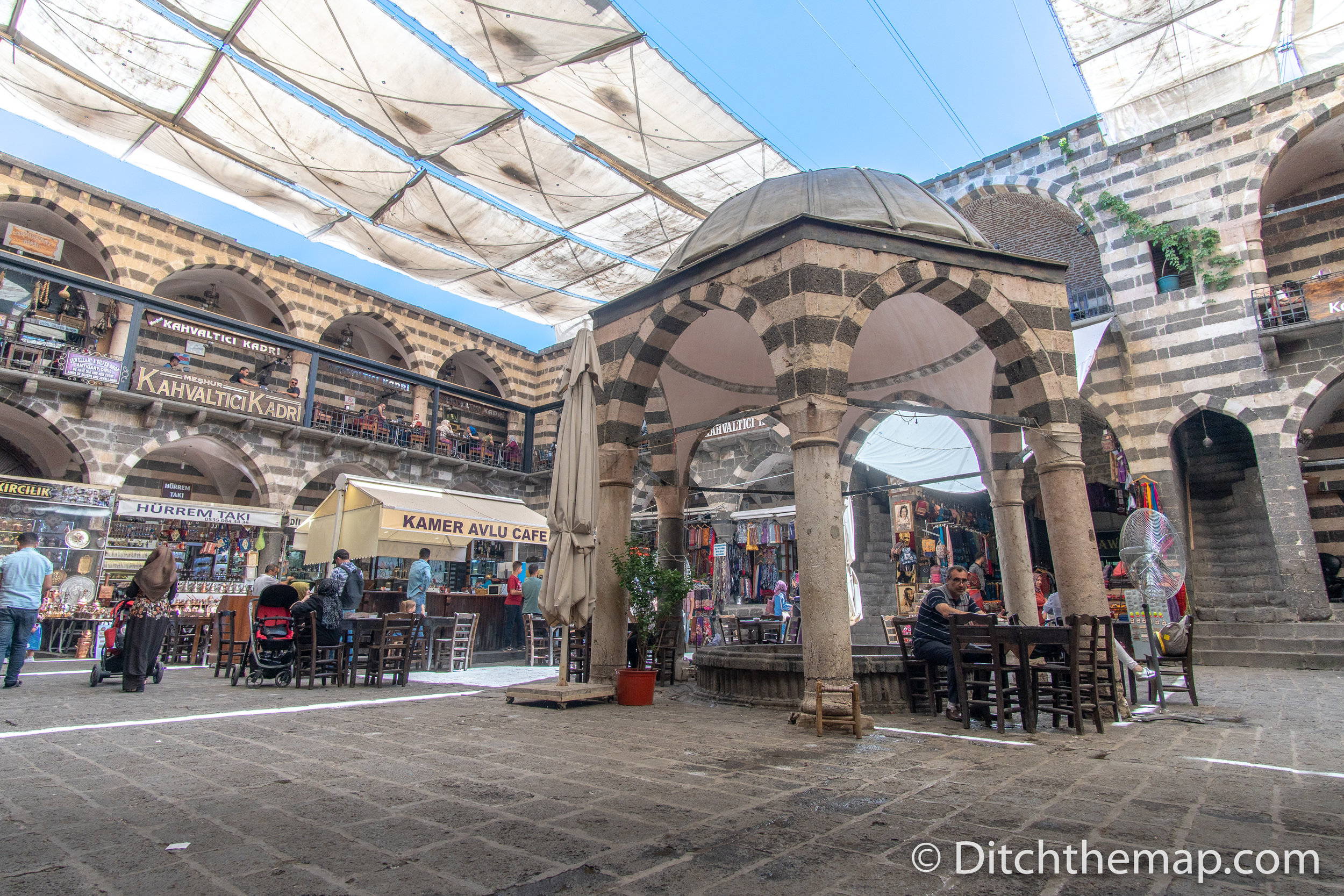
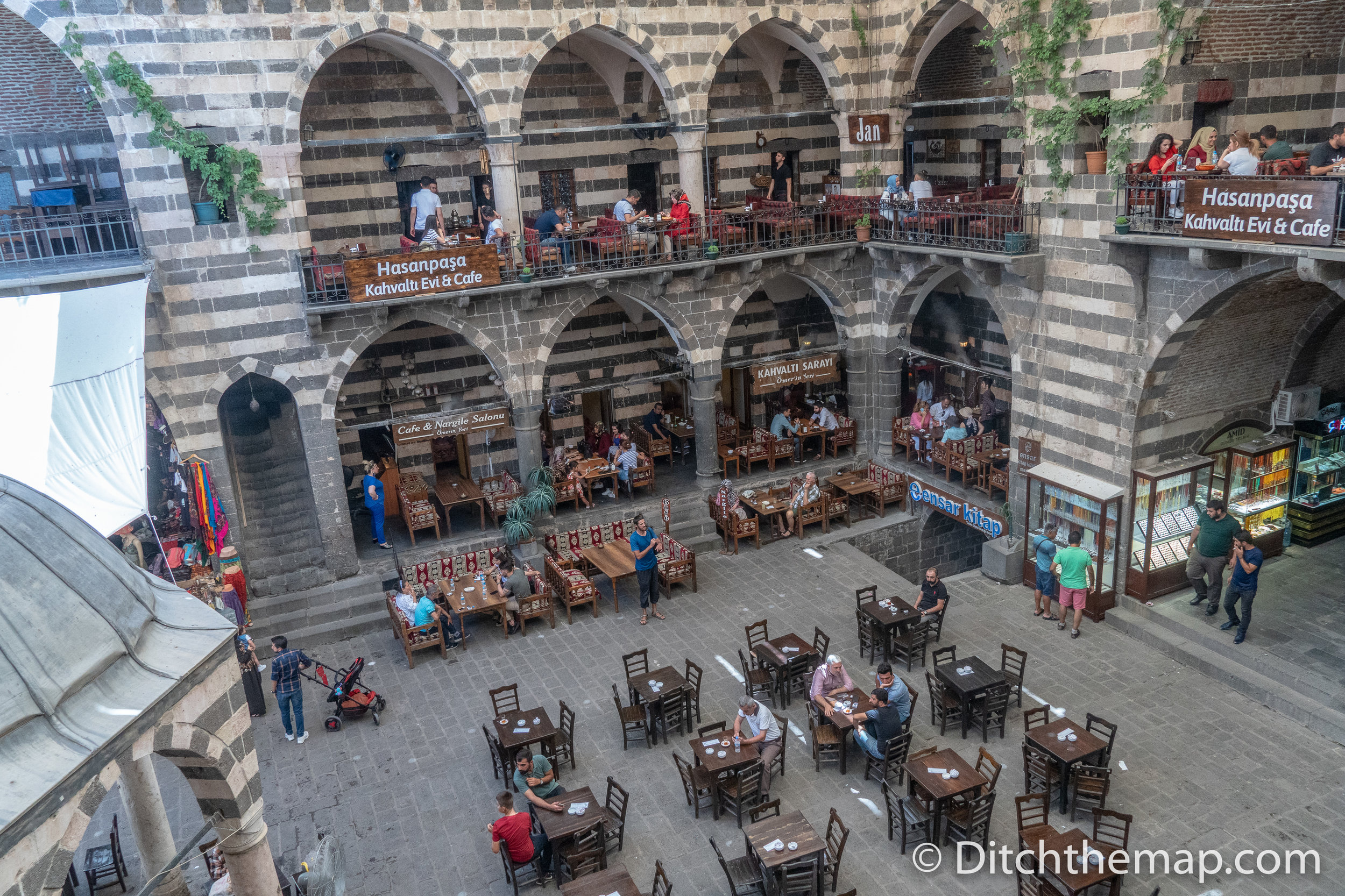
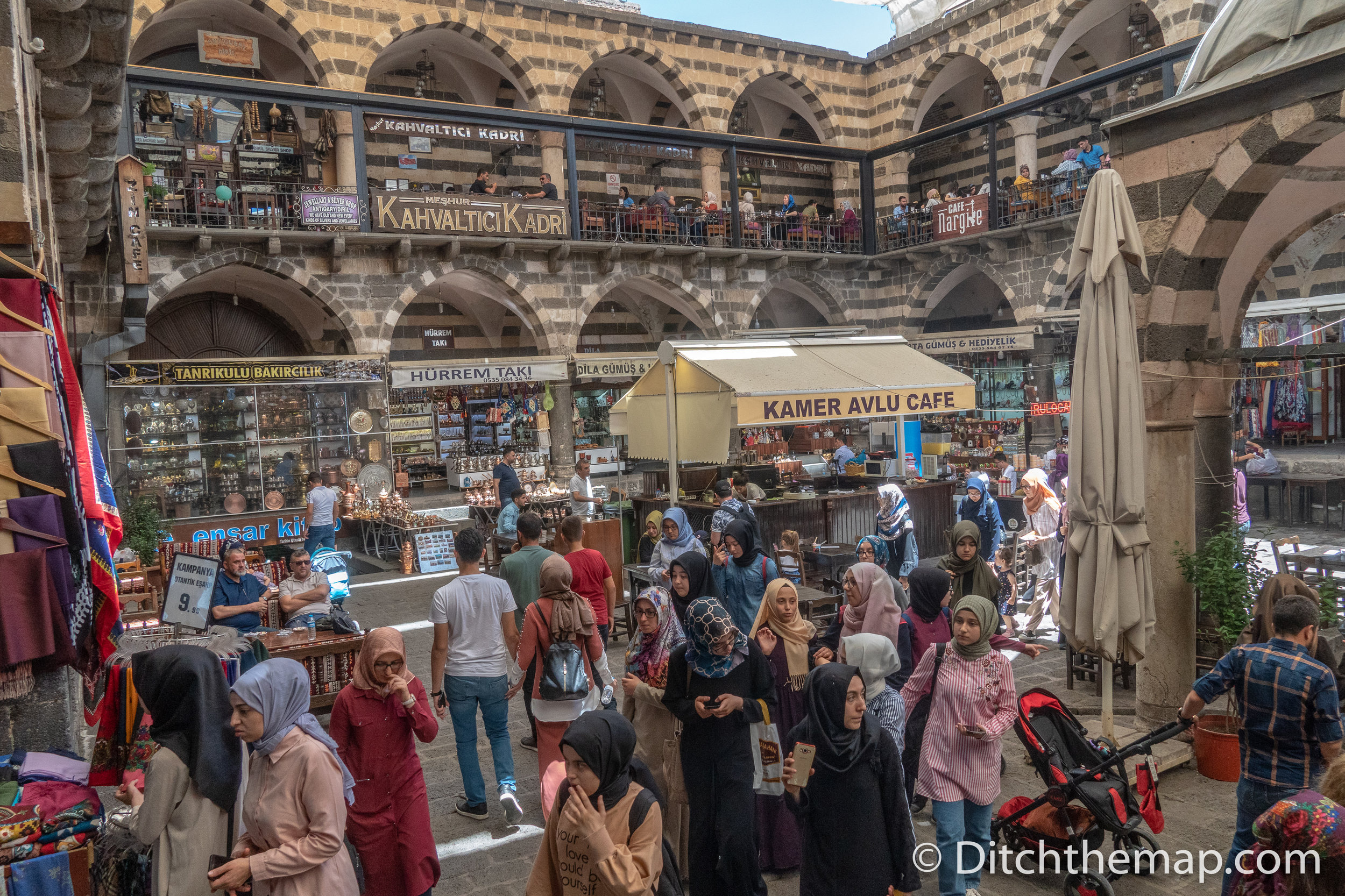
Wikivoyage says it best: “Diyarbakir’s old city is like a village in the middle of the city with village mentality. Goose running around, women having cay in front of their houses and kids shouting to foreigners the few English words they know. However walking around in the city center is unique and totally different from other Turkish cities. You’ll see people as they life their everyday Kurdish life. If you are lucky, you may even get invited for a tea by a friendly shop owner”
Eating watermelon, cheese, and bread on the streets
While walking in Old City many vendors stopped us to ask where we were from. Everyone was so happy to hear that we were from America. One even told us how “Turkey and America are good friends”. While walking near the southern wall I spotted several kebab vendors sitting and enjoying a midday snack. They were eating slices of watermelon, chunks of cheese, and Kurdish bread. When they saw us looking at their food they commanded us to join them. They gave up their seats and forced us to eat, even bringing more bread and cheese. They had to get back to work but after 10 minutes they even gave us a sample of their chicken kebab and another sandwich item. We sat for a while and upon leaving I asked how much we owed and the men held their hands to their chest and said it was a gift. They asked for a photo and we hugged and kissed each other’s cheeks as we departed.
Sylvie and Robert enjoy a Turkish breakfast Sandwich in Diyarbakir
For dinner one night Sylvie and I split a portion of Cig Kofte, a Turkish dish originally made with raw meat. However the government has outlawed the use of raw meat for health and safety reasons. This Cig Kofte was by far the best we’ve eaten and we’ve had at least a couple dozen times. The next morning we came back to the same place and Sylvie and Robert bought a Turkish breakfast sandwich. We watched the men prepare the Cig Kofte for the day and they showed us how they used raw lamb. I was finally happy to have tried Cig Kofte with raw meat. Our host couldn’t believe it as using raw meat is strictly forbidden.
Must-Sees/Dos in Old City:
Include the Great Mosque of Diyarbakir (Ulu Mosque) – 800 years old
Aramaic Church of the Virgin Mary (Meryemana Kilisesi)
Dicle Bridge (ten eye bridge) - Built south of the city in 1065
Kervanseray – Old caravanserai now used as a place for cafes, bookstores, and shop
Hasan Pasha Hani – A 500 year old in that offers best place to get breakfast in Diyarbakir. Come hungry as you can expect your entire table to be overflowing with a variety of Kurdish dishes (found inside Kervanseray)
Eat Cigercisi, preferably at Dag Paki Cigercisi, this liver kebab is unique to Diyarbakir
Eat Kadayif and Kunefe – Two types of desserts famous in the area
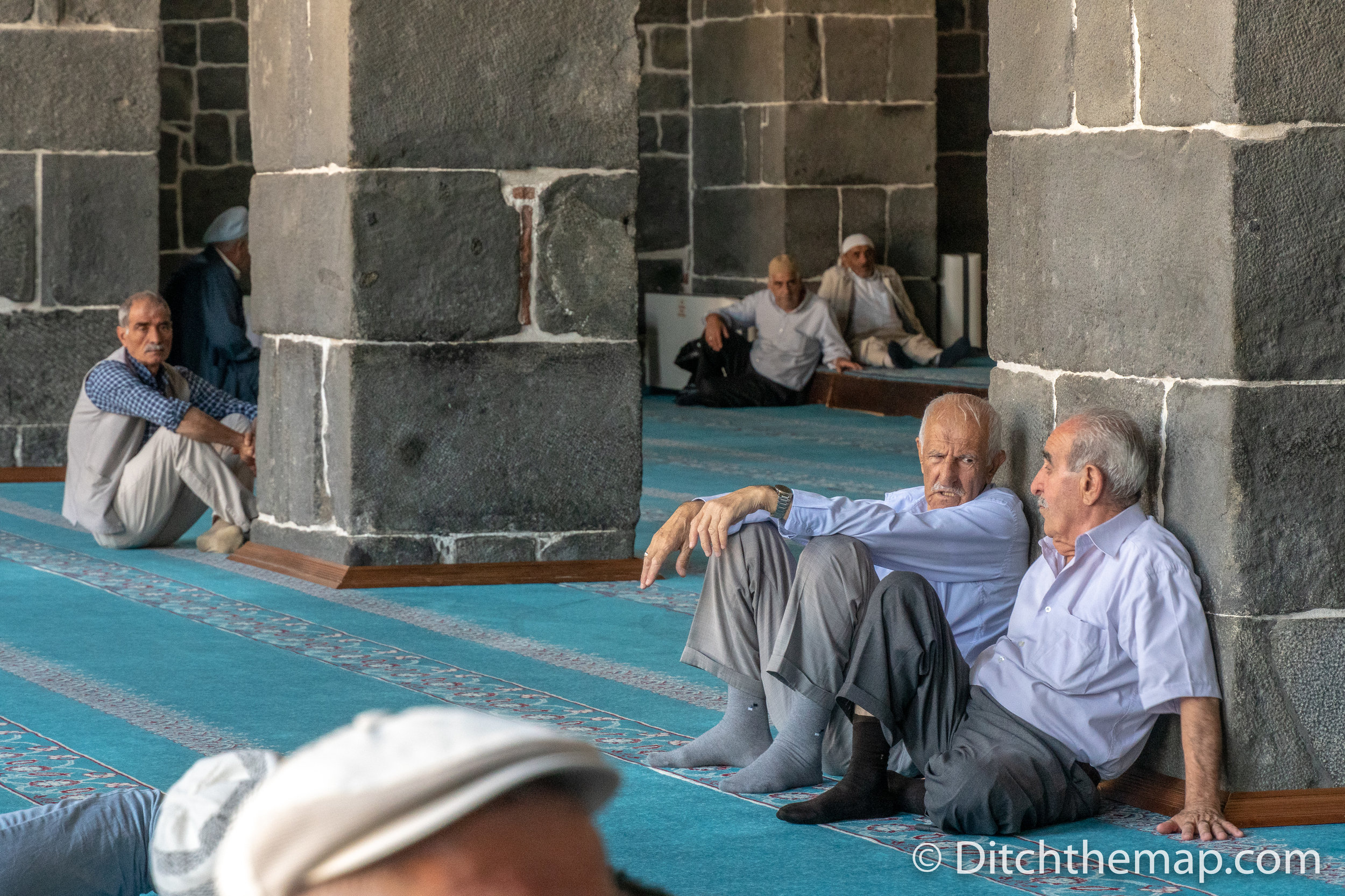
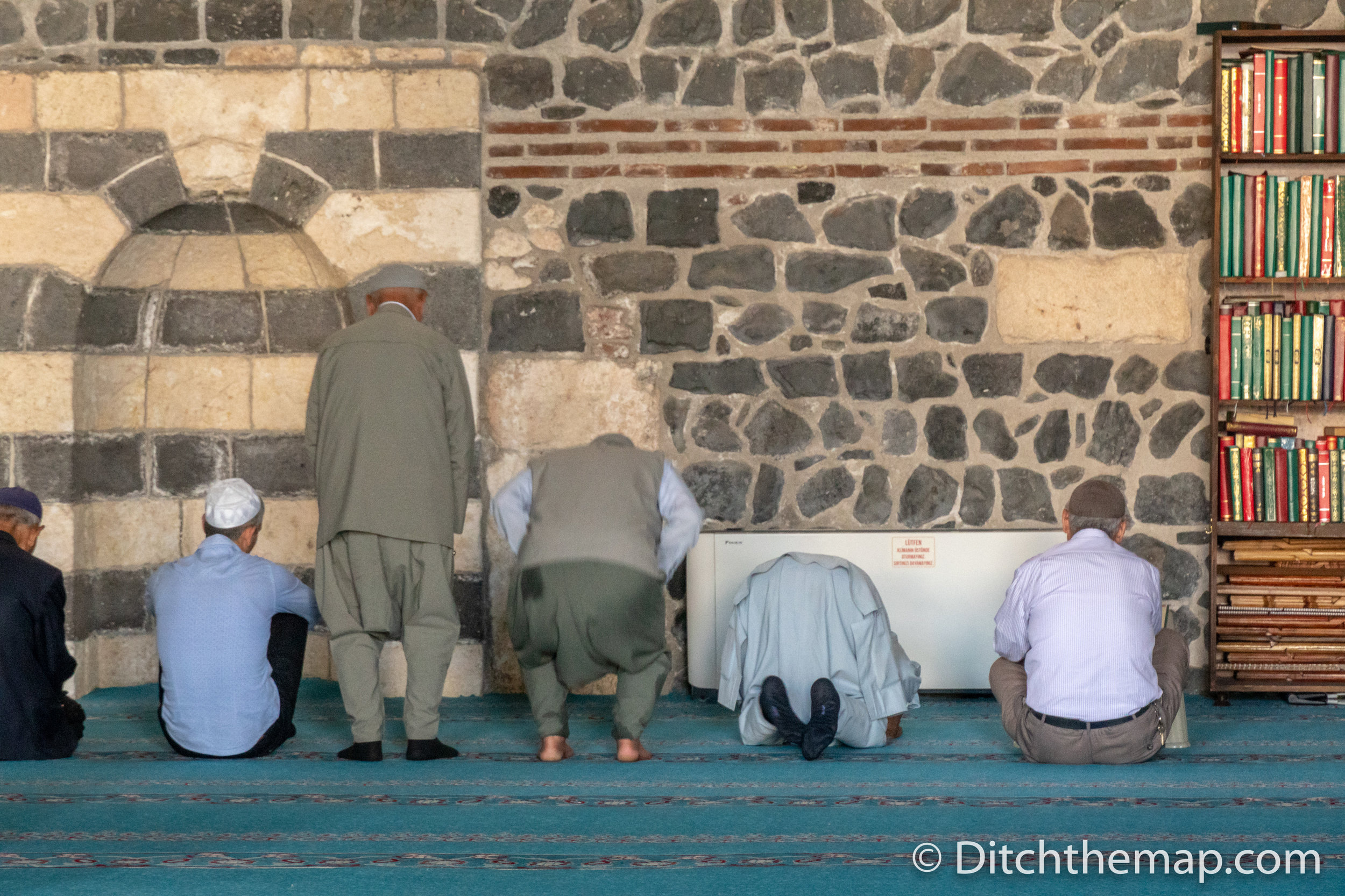
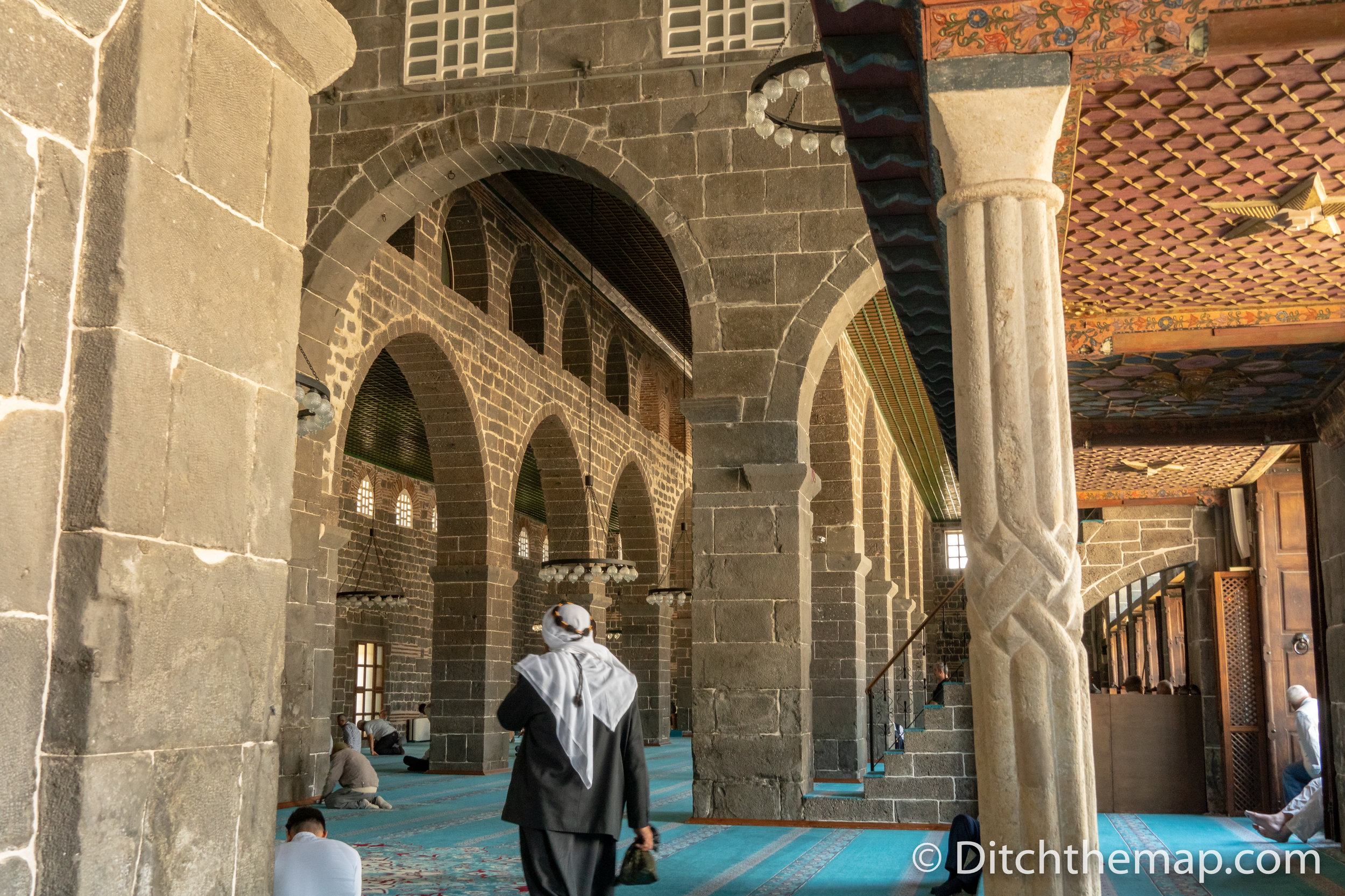
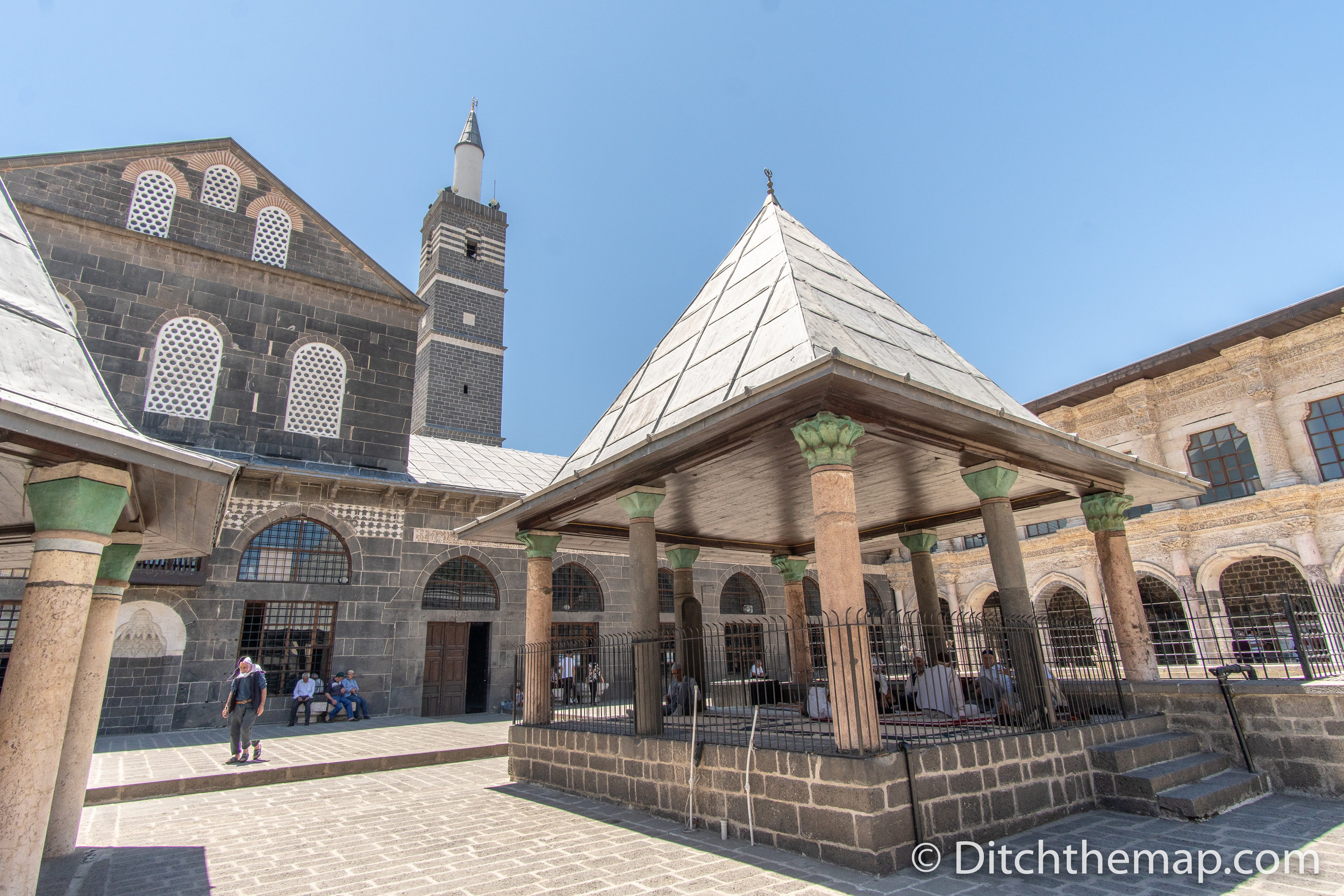

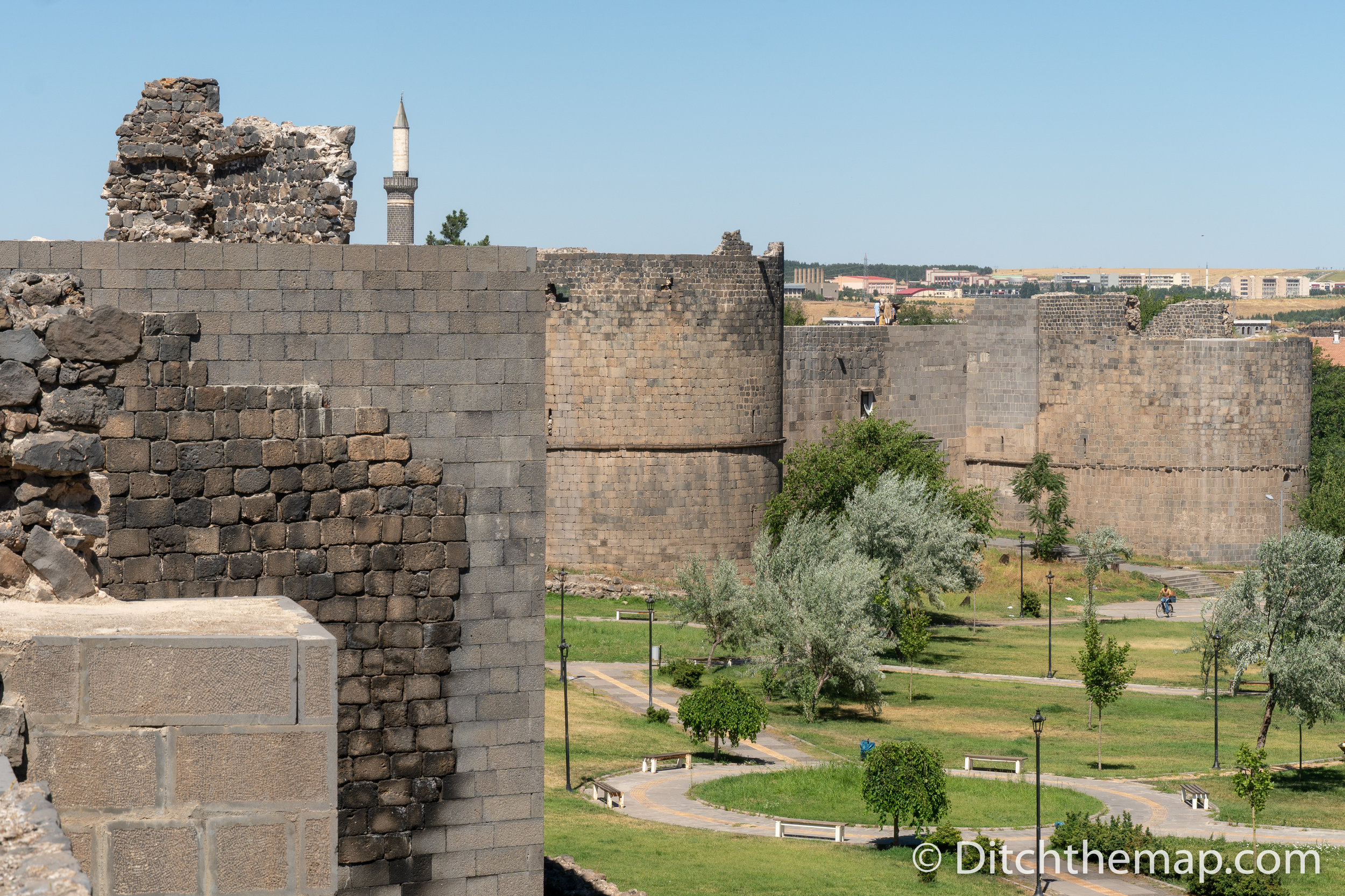

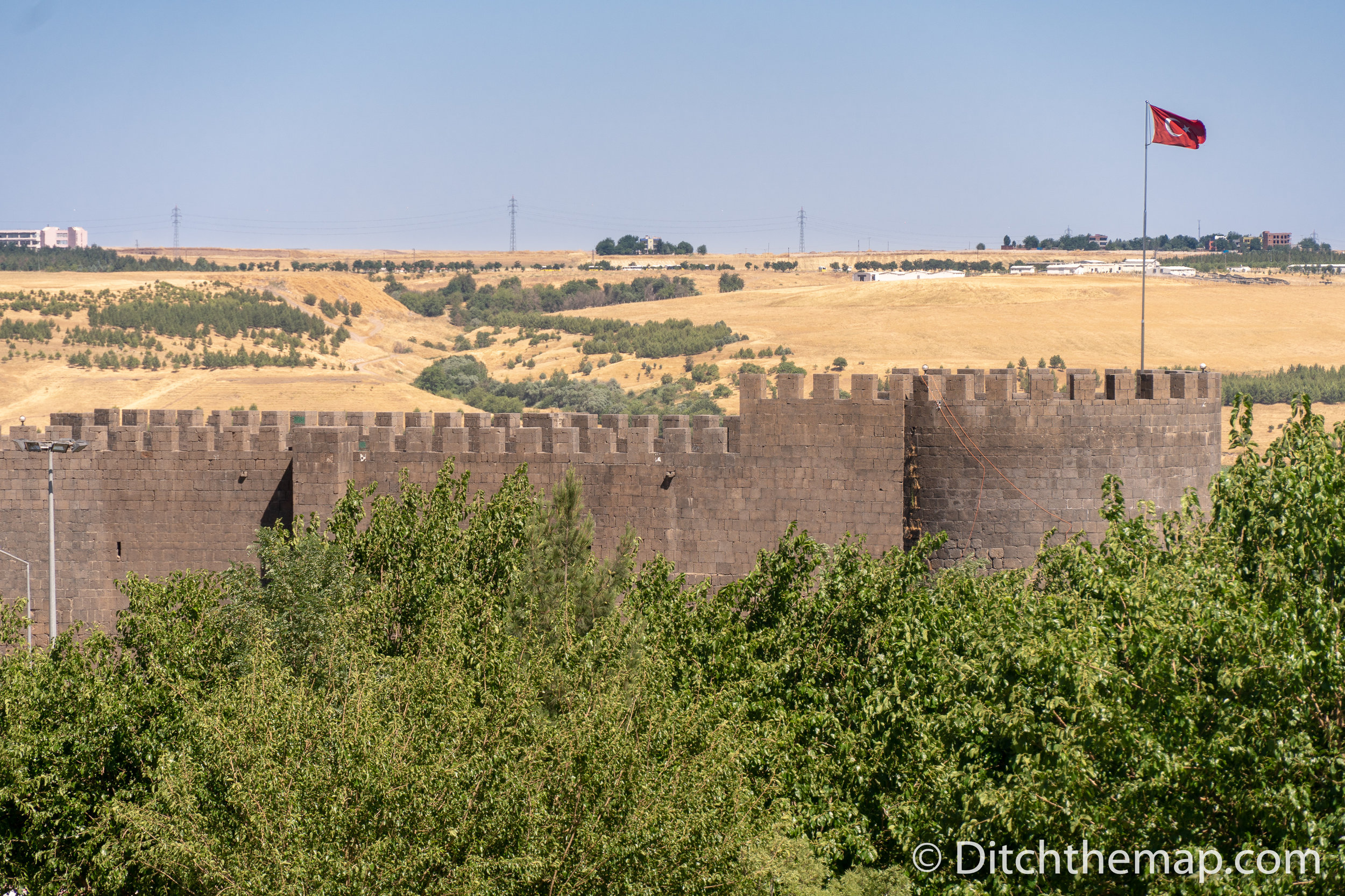
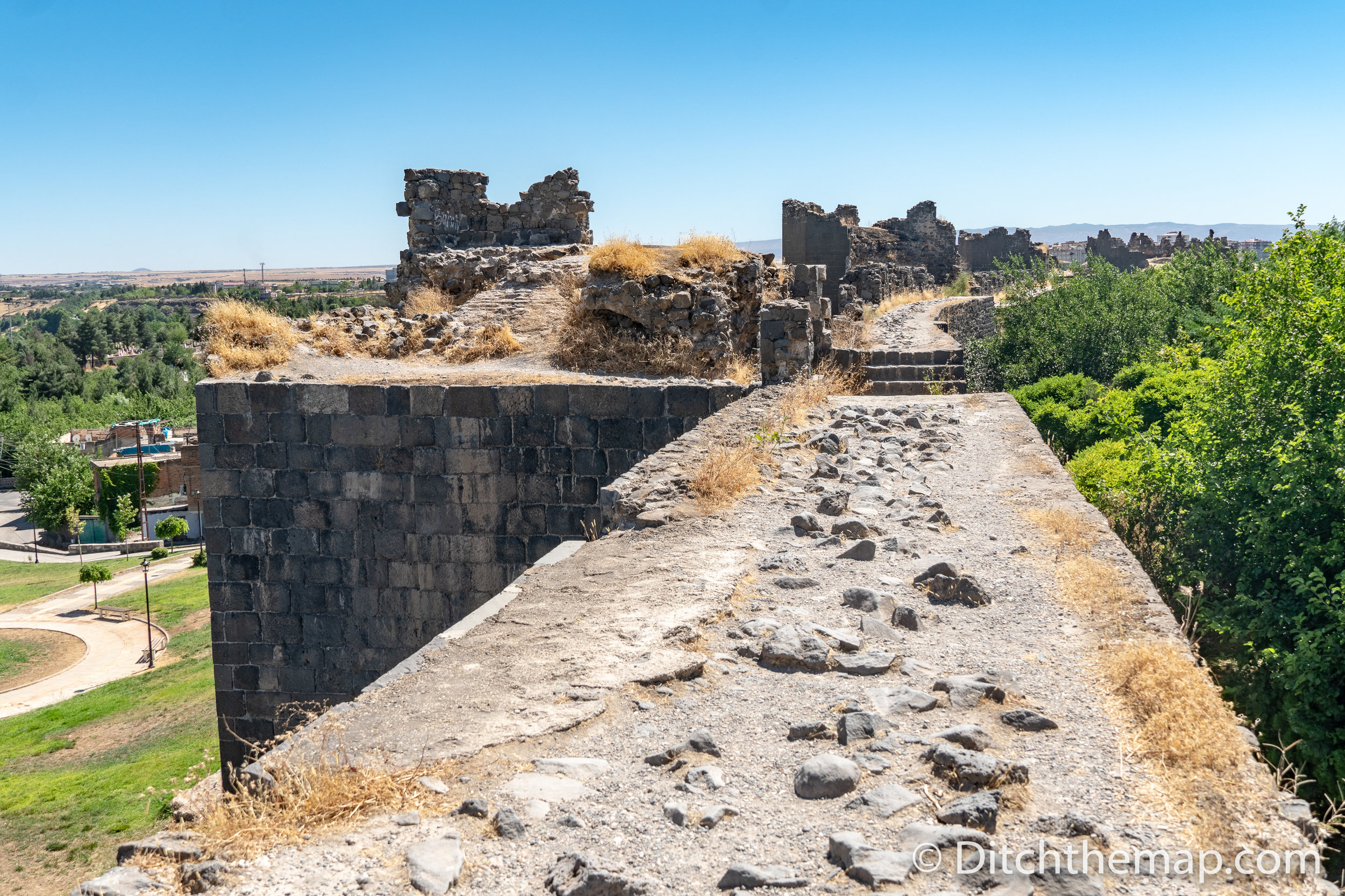
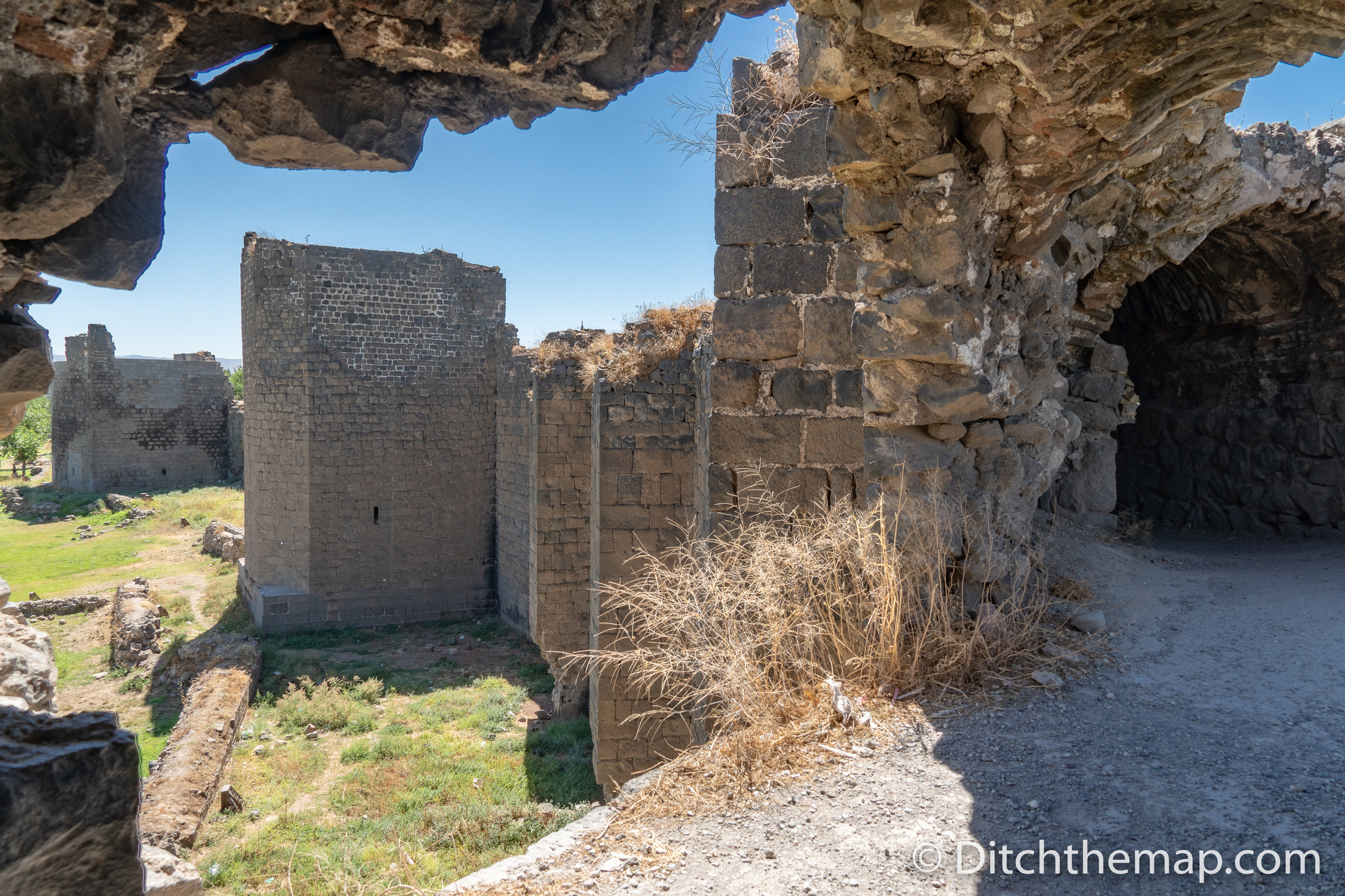
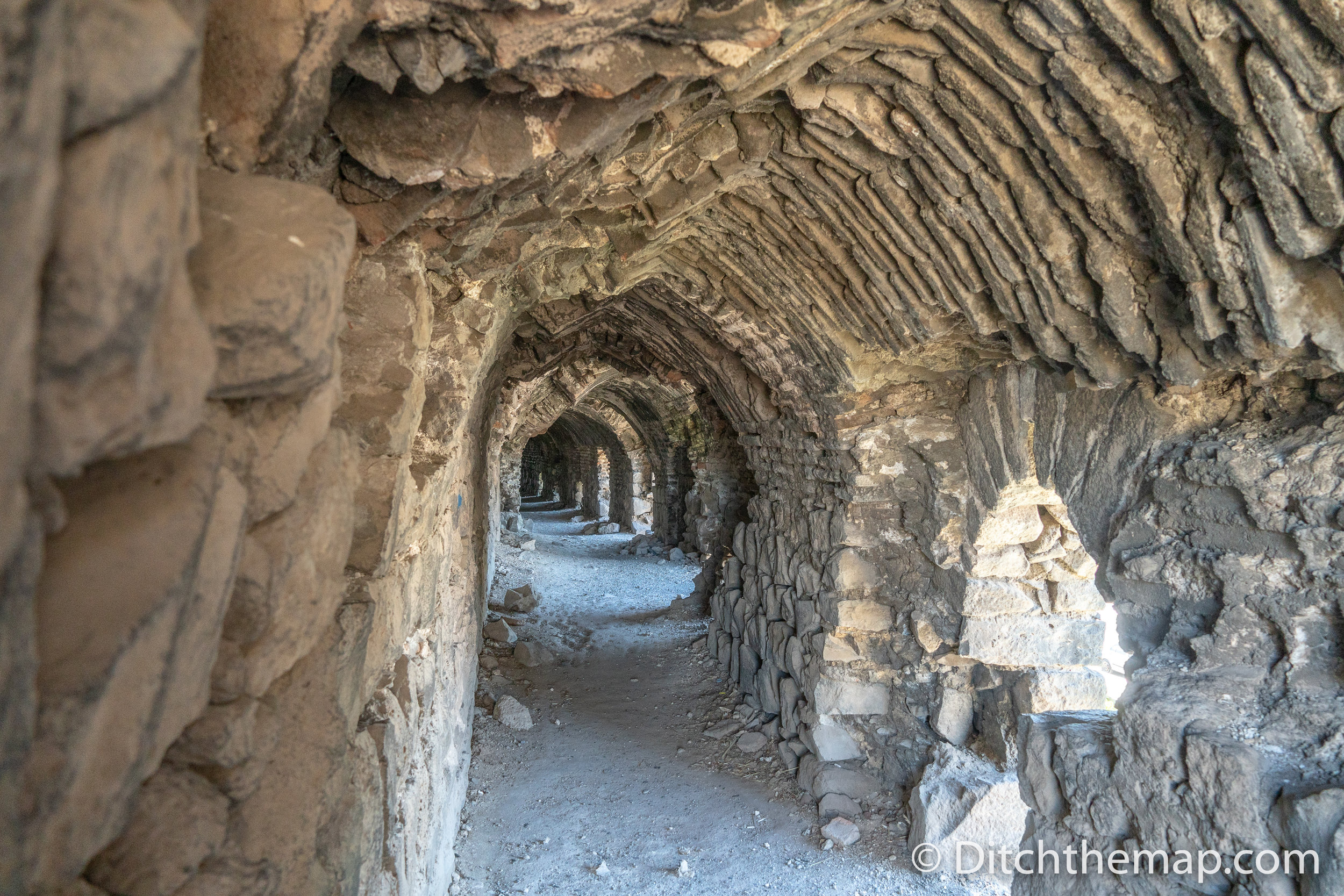
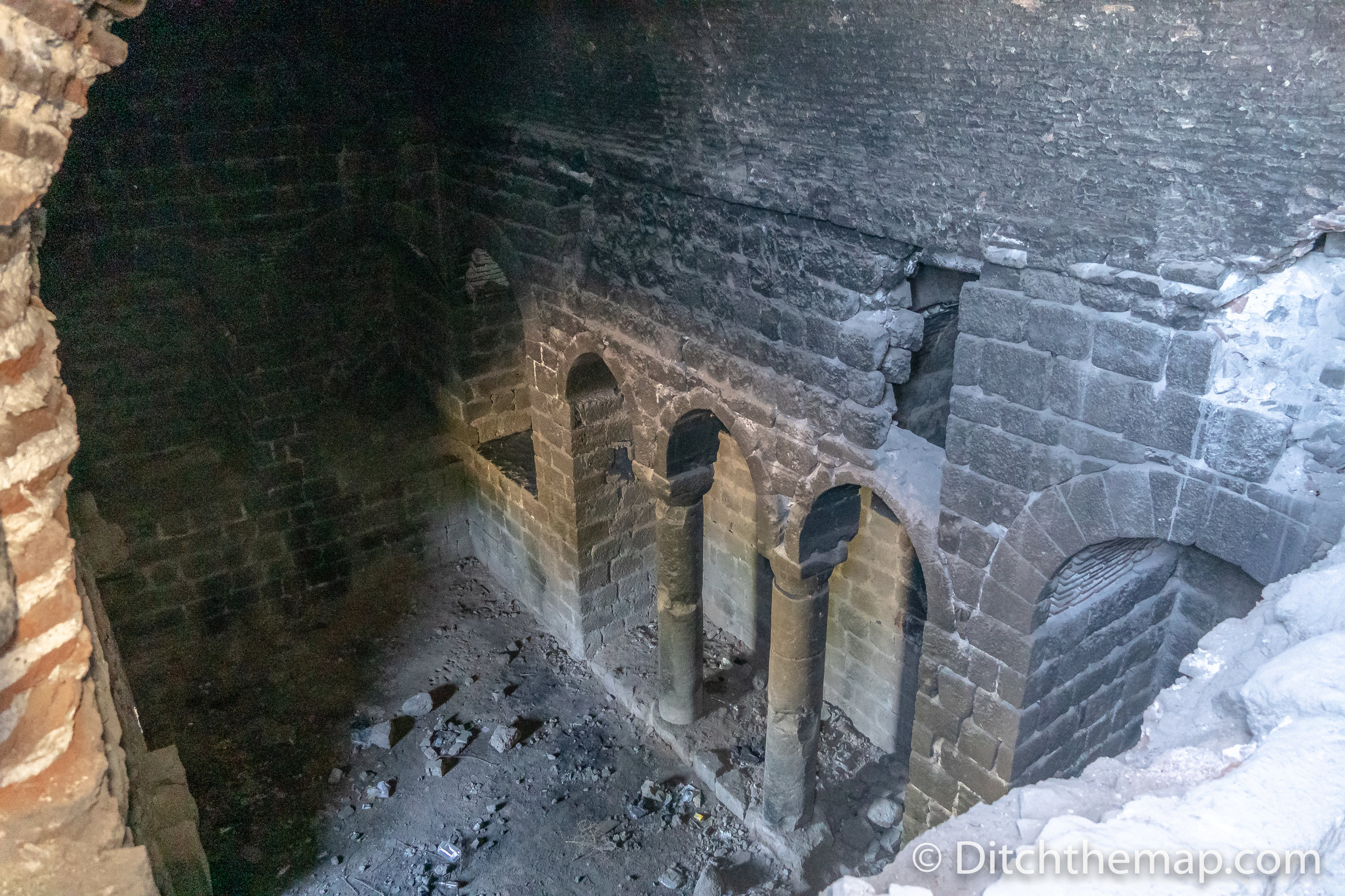
Leaving Diyarbakir
After trying their kadayif we caught a bus to the bus station thanks to a handful of helpful locals trying with great effort to see that we were on our way safely. The bus driver let us off without charging us! As we walked into the bus station no less than 5 men ran up to us screaming names of large cities in Turkey. We said “Urfa” and one gent took us by the arm and brought us to a counter inside the bus terminal. We bought tickets to Urfa for a bus that left in 4 minutes. Sylvie, like always, ran to the bathroom and we were on our way to Urfa within minutes. Within 10 minutes we were already stopped at yet another security checkpoint. This time the police officer was wearing a complete set dessert camouflage. Goodbye Diyarbakir, I’ll surely miss you!


